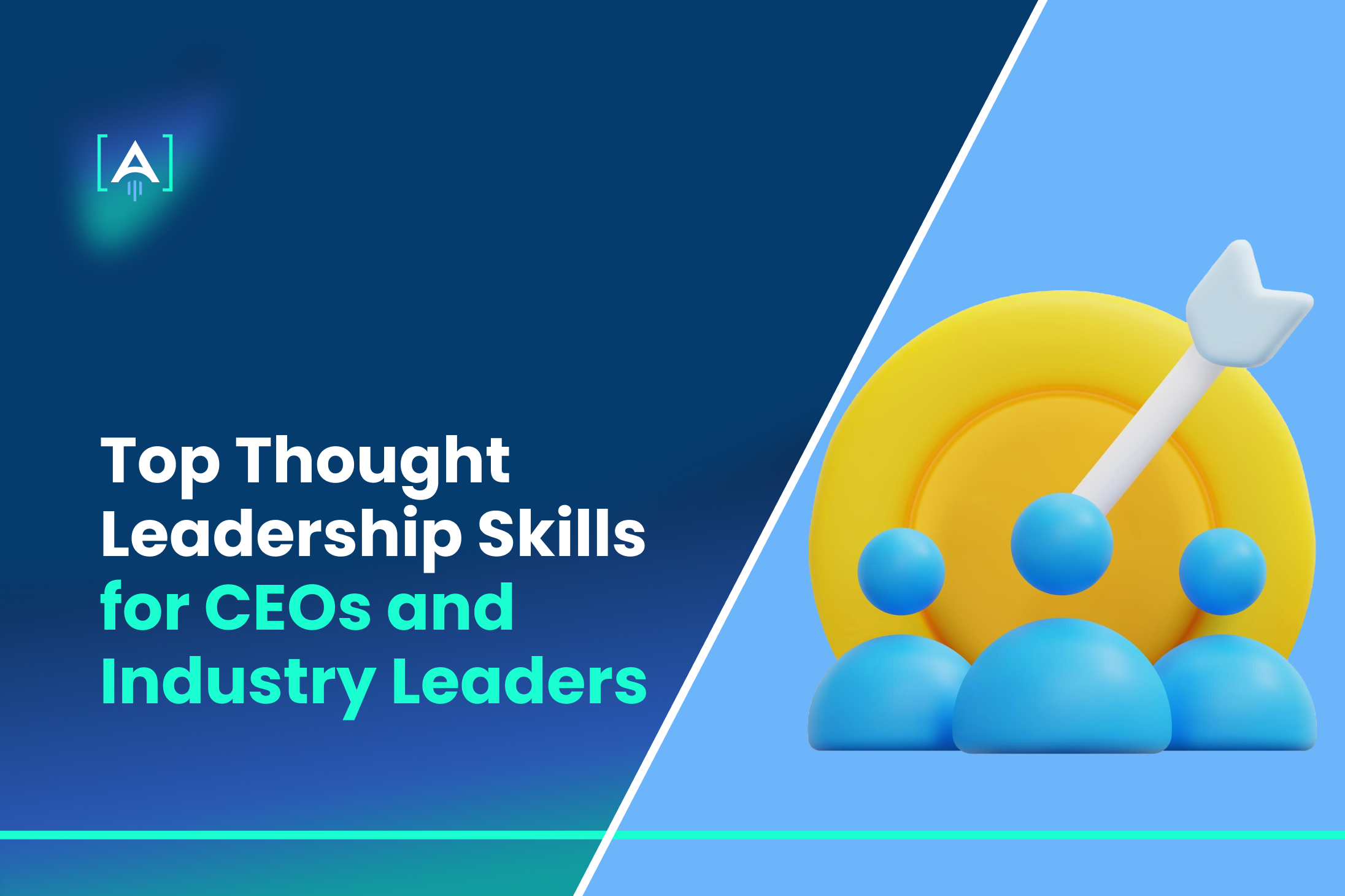In a world where information is readily available, and opinions are easily shared, standing out as a true thought leader is no easy feat.
Yet, for CEOs and industry leaders, it’s a crucial skill that can shape industries, drive innovation, and ultimately define legacies.
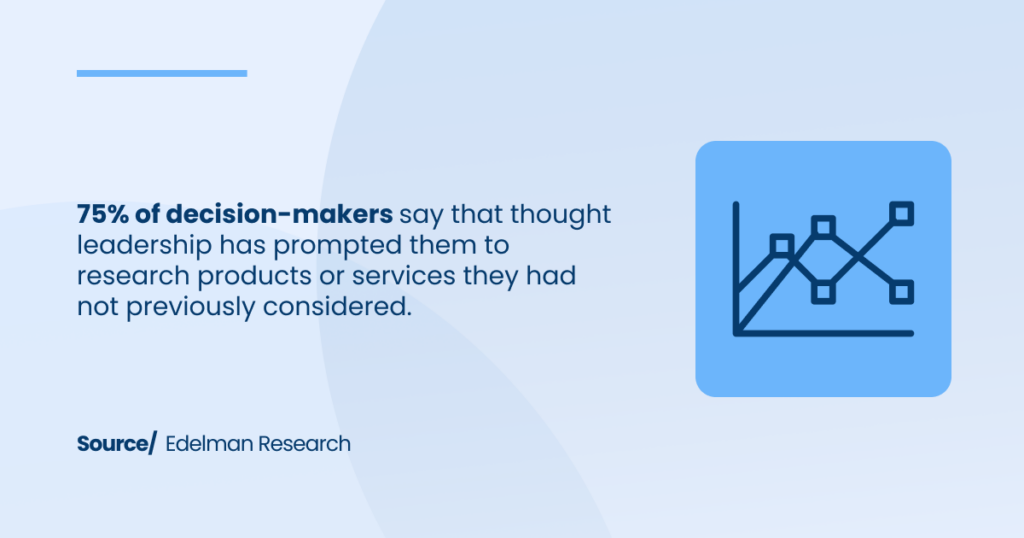
Surprisingly, thought leadership plays a key role not only in attracting and retaining new customers but also in enabling competitors to capture each other’s existing clientele.
A professional Thought Leadership Agency can help you stand out from the market and position you as a trusted authority in your industry.
Let’s explore top Thought Leadership Skills for CEOs and Industry Leaders here.
Influence Starts with Insight – Mastering Emotional Intelligence
A leader’s ability to understand and connect with people is critical.
While expertise and strategic skills are essential, emotional intelligence—the capacity to recognize and manage emotions—has become a defining trait among top industry leaders.
Empathy, self-awareness, and emotional regulation form the backbone of emotional intelligence, allowing CEOs and business owners to lead with genuine impact and inspire loyalty among their teams and customers.
Empathy: The Foundation of Impactful Leadership
Empathy, or the ability to understand and share the feelings of others, is more than just a personal trait—it’s a powerful thought leadership skill.
When CEOs and executives lead with empathy, they establish trust, inspire innovation, and make informed decisions that resonate with both customers and employees.
Research suggests that empathetic leaders are 85% more likely to build stronger and more loyal teams, contributing to lower turnover rates and higher productivity.
Empathy in leadership is about putting yourself in another’s shoes to genuinely understand their challenges, needs, and motivations.
This makes leaders more relatable and human, ultimately reinforcing their brand positioning and authority.
It’s not just a “nice-to-have”; empathy is a business imperative that helps drive results and enhance your strategic brand positioning.
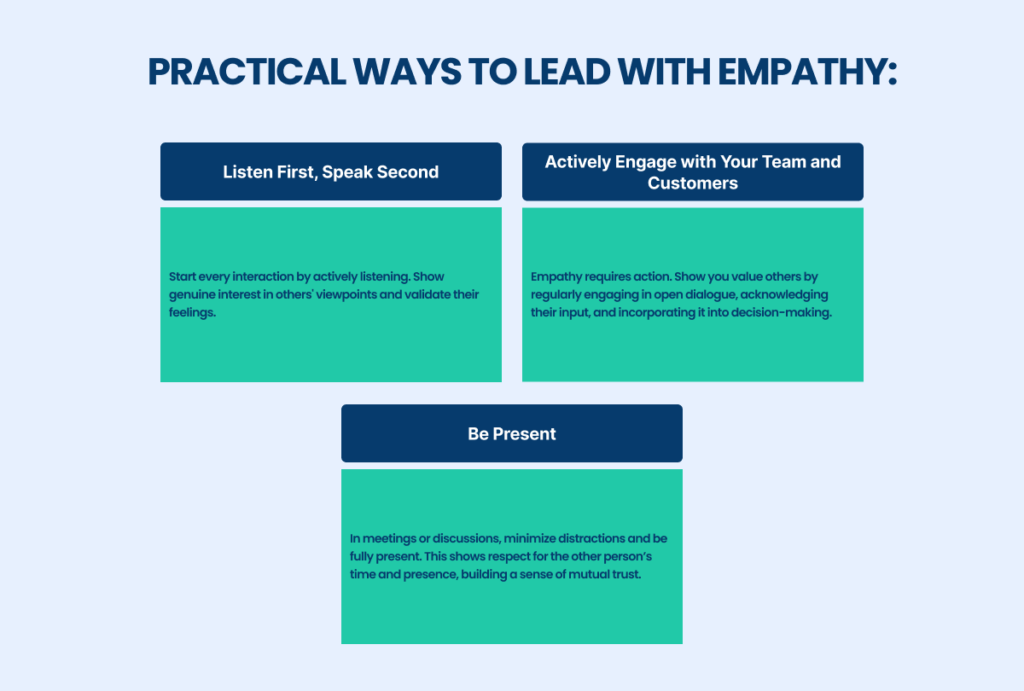
Empathy also translates to better decision-making. Leaders who prioritize empathy are better at predicting and understanding market trends and customer needs.
For example, when facing business challenges, empathy allows leaders to take customer pain points into account, creating solutions that are not only effective but also aligned with their audience’s values and needs.
Self-Awareness: The Key to Authentic Thought Leadership
While empathy helps leaders connect with others, self-awareness strengthens their internal compass, allowing them to stay grounded and authentic.
Self-aware leaders understand their strengths, weaknesses, and triggers, helping them maintain credibility and authenticity, which are crucial in thought leadership.

For CEOs, self-awareness enables them to make balanced, well-thought-out decisions and lead with authenticity.
Self-awareness also aids in identifying the core message or unique value proposition that a leader can offer to the public, forming the foundation of strategic brand positioning.
CEOs who understand their own motivators and areas for improvement are better equipped to inspire their teams and project authenticity in their digital PR strategies.
Building Self-Awareness:
- Seek Honest Feedback: Regularly ask for feedback from colleagues, mentors, or trusted peers. Constructive feedback from those around you provides valuable insight into areas where you can grow.
- Practice Reflection: At the end of each day, take a few moments to reflect on your actions and interactions. Identify moments when you were at your best and areas where you could improve.
- Set Personal Goals for Growth: Outline clear, measurable goals for developing your emotional intelligence. By actively working on your emotional responses, you can become a more resilient and focused leader.
Self-awareness supports thought leadership best practices, helping leaders maintain a consistent and genuine voice.
In thought leadership, where credibility and trust are paramount, self-aware leaders avoid over-promising and focus on delivering authentic value, and building long-term trust with their audience.
Listen More, Lead Better: Why CEOs Who Listen Become Industry Influencers
Listening is often overlooked as a leadership skill, but in reality, it is one of the most powerful tools a CEO can use to connect with their team and customers.
CEOs who actively listen to their employees, clients, and competitors gain insights that strengthen their thought leadership strategies.
Effective listening fosters open communication, encourages innovation, and builds trust, which are foundational for thought leadership.
Studies have shown that companies with leaders who actively listen have 70% more engaged employees and achieve higher customer satisfaction.
This approach enhances thought leadership best practices by ensuring that the leader’s vision aligns with the needs and expectations of their audience.
Creating Open Channels for Communication:
- Establish Regular Feedback Loops: Actively seek feedback from team members and customers through regular check-ins, surveys, or open forums. This gives them a voice and makes them feel valued.
- Respond and Adapt: Listening is only half the equation; acting on the feedback is where true change happens. Show appreciation for input and incorporate it into decision-making when possible.
- Encourage Open Dialogue: Foster a culture where employees feel comfortable sharing ideas or concerns without fear of retribution. This kind of openness leads to innovation and allows for rapid problem-solving.
Active listening can also be invaluable for digital PR strategies as it helps leaders remain in touch with public sentiment, allowing them to respond to emerging trends and shifting expectations quickly.
By truly listening, CEOs can make more informed decisions, communicate with purpose, and establish themselves as approachable, influential figures in their industries.
Thought Leadership in Action: Applying Emotional Intelligence to Your Brand
Empathy, self-awareness, and emotional regulation not only enhance your interpersonal skills but are essential for effective thought leadership.
When leveraged strategically, these qualities position you as a trusted authority in your industry, someone whom people want to follow and learn from.
To further strengthen your brand positioning and resonate with your audience, consider these actionable steps:
- Share Personal Stories: Thought leaders who share real-life experiences related to empathy or emotional growth can create a powerful connection with their audience. This positions you as a relatable figure who has learned from experience.
- Prioritize Transparency: Transparency in both victories and challenges showcases authenticity and builds trust. When you openly discuss your journey and share valuable insights, you invite your audience to trust and respect you.
- Use Data-Driven Insights: Supporting your thought leadership with data and real-world statistics reinforces your credibility. For instance, discussing the impact of empathy on employee retention, backed by statistics, can make a strong case for other leaders to prioritize emotional intelligence.
Agility in Action: Leading Through Constant Change
In today’s world, agility isn’t just a buzzword—it’s a necessity.
Business landscapes are changing faster than ever, and flexibility has become a critical thought leadership skill for CEOs who want to keep their organizations ahead of the curve.
But what does agility really mean for a leader? It’s the ability to pivot quickly, respond to market shifts, and make adjustments that don’t just keep the business afloat but allow it to thrive.
To navigate these changes successfully, CEOs must cultivate a mindset that embraces change rather than resists it.
Agile leaders can quickly assess new information, rethink strategies, and adapt to stay relevant.
Why Agility is Essential for Thought Leadership
As a CEO, showing agility demonstrates strategic brand positioning to your stakeholders. It tells employees, customers, and competitors alike that you’re proactive, resilient, and ready to handle whatever comes your way.
This agility is a powerful way of building brand authority, as it reinforces a forward-thinking mindset that’s attractive in an era of rapid change.
Agility is also a vital part of thought leadership strategies, allowing you to offer timely insights, relevant content, and a strong example of leadership. Thought leaders in business aren’t just thought leaders in stable times; they are the ones who guide their industries even when things are unpredictable.
Did you know? Companies with agile leadership are 70% more likely to perform better in volatile markets.
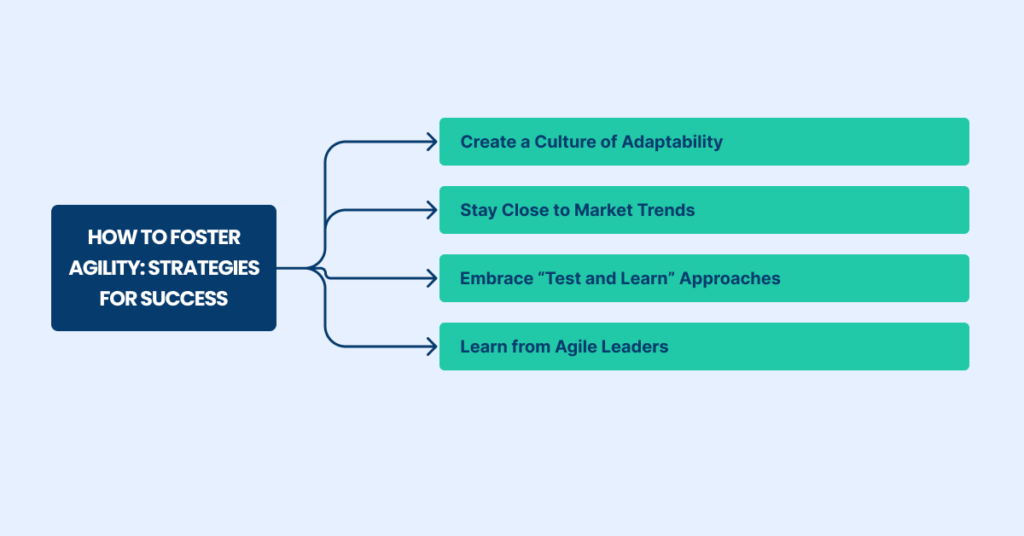
Why “Future-Proofing” is the New Imperative for CEOs
In an increasingly complex and unpredictable market, future-proofing has become a strategic necessity for CEOs. It’s about creating a business model and leadership approach that can withstand shocks and adapt to future challenges.
With digital disruptions, shifting customer expectations, and new competitors on the rise, future-proofing isn’t a luxury—it’s a competitive advantage.
But how exactly do CEOs go about future-proofing their organizations? It starts with understanding trends, anticipating challenges, and investing in resilience. Proactive CEOs aren’t just reactive; they’re visionary, looking beyond immediate gains to ensure their companies stay robust and adaptable.
Why is Future-Proofing Important for Thought Leadership?
Future-proofing aligns closely with thought leadership skills, as it requires insight, adaptability, and foresight.
CEOs who prioritize future-proofing solidify their brand authority by positioning themselves as leaders who aren’t just thinking about today but are prepared for tomorrow. This forward-looking approach builds confidence among investors, employees, and clients, establishing you as a leader who’s in control and ready for what’s next.
Statistically speaking, companies that invest in future-proofing strategies see up to 2x more sustainable growth over five years compared to those that don’t. This data alone underscores why future-proofing isn’t just beneficial but essential.
Crafting a Compelling Narrative – Communication as a Leadership Superpower
When it comes to building trust and influence, data and facts can only go so far. Stories are what resonate, inspire, and connect us on a personal level.
For CEOs, brand storytelling techniques are more than just a tool; it’s a bridge that connects vision with values, the company with its customers, and the leader with the people. It’s through stories that thought leaders humanize their brand, making it relatable and memorable.
Consider this: a study by Harvard Business Review found that messages delivered as stories are 22 times more memorable than simple facts. When CEOs use storytelling to share their journey, values, and mission, they create a narrative that sticks with audiences long after the message is over.
How Storytelling Builds Trust and Authority
- Shows Authenticity: Stories reveal the “why” behind a CEO’s mission, giving audiences a peek into their values, struggles, and motivations. This transparency fosters trust, a cornerstone of thought leadership.
- Adds Emotional Weight: People relate more to real-life struggles and achievements than to abstract ideas. By sharing personal stories or experiences, CEOs make their message resonate on a deeper emotional level.
- Creates Shared Experiences: When a story aligns with the audience’s own experiences, it forms a bond. This shared understanding establishes CEOs as not only leaders but as trusted guides within their industry.
In essence, storytelling transforms thought leadership from a monologue into a conversation, inviting your audience to become part of a vision that’s bigger than just business.
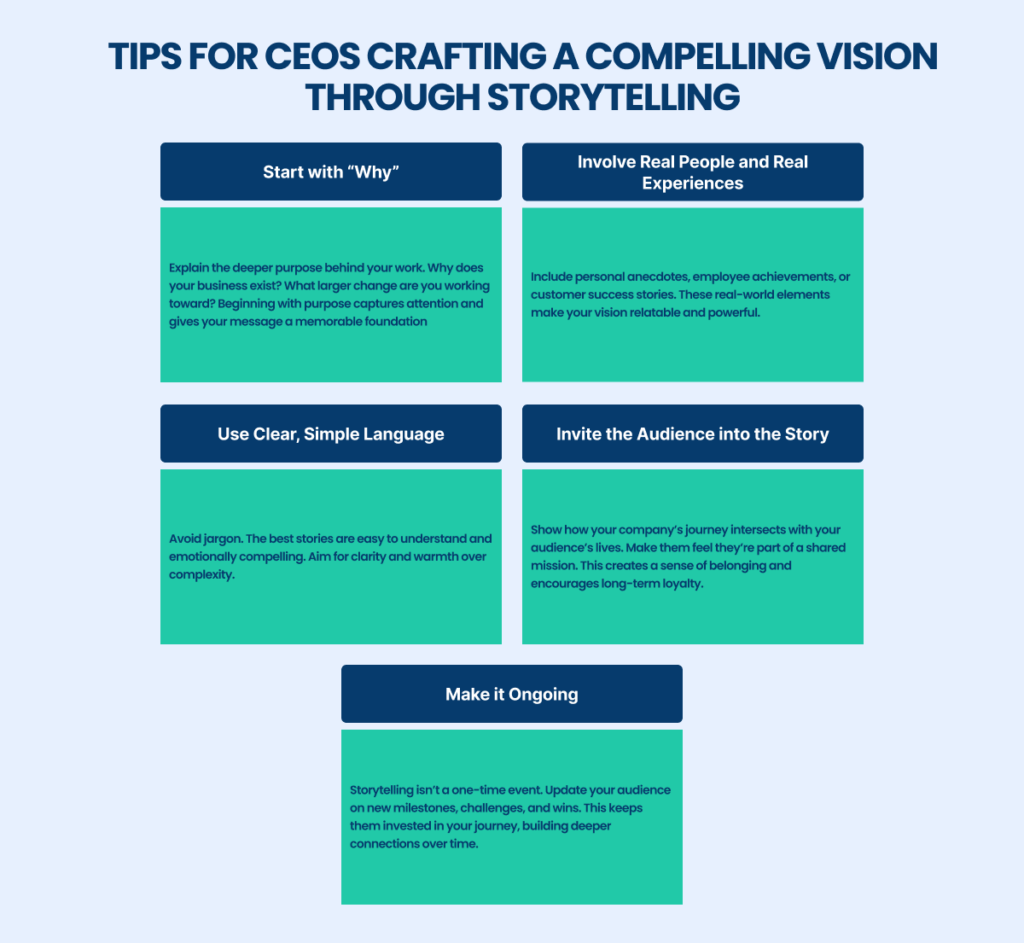
Leading on Social Media – How CEOs Build Influence Online
For today’s CEOs, social media isn’t just a platform; it’s a stage.
Social media allows leaders to showcase their expertise, amplify their vision, and connect directly with audiences on a daily basis.
With billions of people on social platforms every day, an active online presence is critical for establishing brand authority, showcasing thought leadership skills, and staying top-of-mind for your industry.
A strong digital presence is also a strategic way to boost and improve thought leadership and SEO rankings, as high-quality, regularly updated content increases visibility.
Studies show that 82% of consumers feel more positive about a company when its CEO is active on social media, highlighting the direct impact of online engagement on brand perception.
Benefits of a Social Media Presence for CEOs
- Demonstrates Accessibility: A CEO who regularly posts and engages on social media is seen as accessible and in touch with real-world issues and customer feedback.
- Builds Credibility and Influence: Sharing industry insights, new ideas, and responding to trends establishes credibility and positions CEOs as thought leaders in their space.
- Humanizes the Brand: Social media offers CEOs a chance to share not just achievements but values, challenges, and a human perspective that fosters trust and connection.
Data-Driven Decision Making – Transforming Instinct into Insight
Relying solely on gut feeling can leave even the most experienced CEOs vulnerable to risks.
Data-driven decision-making has become essential for staying competitive and confidently leading a company toward its goals. CEOs today are expected to move beyond instinct, embracing data as a powerful tool for making informed choices that align with their organization’s vision.
With a data-driven approach, CEOs can back up their intuition with concrete insights, turning assumptions into evidence-based strategies.
In fact, 87% of leading companies believe that data is essential to staying competitive.
Moving toward a data-driven model doesn’t mean losing the human element in leadership.
Rather, it empowers CEOs to make smarter, faster decisions based on reliable insights. This balance of intuition and data is what separates industry leaders from followers.
Benefits of a Data-Driven Approach in Thought Leadership
- Improved Accuracy: Data removes the guesswork, helping CEOs make precise decisions that are in tune with current trends and demands.
- Enhanced Predictability: By analyzing patterns, data can forecast future trends, allowing CEOs to anticipate market shifts and stay ahead.
- Stronger Accountability: Data provides an objective foundation for decision-making, making it easier to justify choices to stakeholders, investors, and teams.
Building Strong Networks – Connections That Propel Success
Thought leadership isn’t built in isolation. The connections CEOs cultivate—mentors, advisors, and industry peers—serve as a support system that can significantly amplify their influence and strategic impact.
A robust network doesn’t just offer resources; it provides fresh perspectives, valuable insights, and growth opportunities that can propel both individual leaders and their organizations forward.
According to a LinkedIn report, 80% of professionals consider networking essential for career success. For CEOs, a network is even more critical, as it serves as a platform for collaboration, learning, and gaining visibility.
The right connections can open doors to new partnerships, potential investors, and thought leadership opportunities that would otherwise remain out of reach.
Key Advantages of a Strategic Network for CEOs
- Increased Visibility: A strong network positions you within influential circles, expanding your reach and establishing you as a thought leader.
- Access to New Ideas: By connecting with diverse leaders, CEOs gain access to fresh ideas, fostering innovation and continuous learning.
- Resource and Support System: A reliable network offers resources and support during challenging times, making problem-solving more collaborative and less isolating.
Mentors, Advisors, and Peers – The CEO’s Support System: How a Trusted Circle of Allies Fuels Leadership Growth
Every CEO needs a circle of trusted advisors—mentors, peers, and industry experts who provide guidance and insights. This support network not only strengthens decision-making but also adds a layer of accountability and feedback, which is essential for any thought leader.
Great leaders understand that seeking advice isn’t a weakness but a way to stay grounded and well-informed.
Building a Trusted Circle for Lasting Leadership Impact
- Identify Strategic Mentors: Seek out mentors whose experience and values align with your goals. These mentors offer wisdom and a fresh perspective, helping you navigate complex challenges.
- Leverage Peer Networks: Engaging with other CEOs and industry leaders offers valuable insights into best practices, market trends, and potential pitfalls. Peer networks serve as a sounding board, offering perspectives only other leaders can understand.
- Establish Advisory Relationships: Advisors bring specialized knowledge in areas like finance, operations, or digital strategy. Regular advisory sessions ensure you’re aligned with best practices and emerging trends.
- Nurture Your Network: Networks are a two-way street. Make an effort to maintain and grow your connections by offering help, sharing insights, and supporting others in their journey.
The Takeaway: Thought Leadership for the Modern CEO
Mastering top thought leadership skills goes beyond mastering strategy or innovation. It’s about shaping the future of your industry with vision, empathy, and adaptability.
[A] Growth Agency understands this journey well. We help leaders to harness the skills to set new standards, inspire teams, and drive sustainable growth. Our experienced team supports leaders in building authentic connections and communicating their vision effectively.
Thought leadership isn’t a one-size-fits-all approach. It’s a custom-built strategy that aligns with your unique values and goals.
We guide you in identifying the right content strategies and creating a digital presence that amplifies your impact.If this is what you are in search of, let’s get started together.
